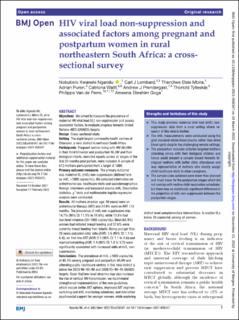| dc.contributor.author | Ngandu, Nobubelo Kwanele | |
| dc.contributor.author | Lombard, Carl | |
| dc.contributor.author | Mbira, Thandiwe Elsie | |
| dc.contributor.author | Puren, Adrian | |
| dc.contributor.author | Waitt, Catriona | |
| dc.contributor.author | Prendergast, Andrew J. | |
| dc.contributor.author | Tylleskär, Thorkild | |
| dc.contributor.author | Van de Perre, Philippe | |
| dc.contributor.author | Goga, Ameena | |
| dc.date.accessioned | 2022-12-28T09:31:55Z | |
| dc.date.available | 2022-12-28T09:31:55Z | |
| dc.date.created | 2022-04-01T18:51:48Z | |
| dc.date.issued | 2022 | |
| dc.identifier.issn | 2044-6055 | |
| dc.identifier.uri | https://hdl.handle.net/11250/3039612 | |
| dc.description.abstract | Objectives We aimed to measure the prevalence of maternal HIV viral load (VL) non-suppression and assess associated factors, to evaluate progress towards United Nations-AIDS (UNAIDS) targets.
Design Cross-sectional study.
Setting The eight largest community health centres of Ehlanzeni, a rural district in northeast South Africa.
Participants Pregnant women living with HIV (WLHIV) in their third trimester and postpartum WLHIV and their biological infants, recruited equally across all stages of the first 24 months post partum, were included. A sample of 612 mothers participated from a target of 1000.
Primary outcome measures The primary outcome was maternal VL (mVL) non-suppression (defined here as mVL >1000 copies/mL). We collected information on antiretroviral use, healthcare visits and sociodemographics through interviews and measured plasma mVL. Descriptive statistics, χ2 tests and multivariable logistic regression analysis were conducted.
Results All mothers (median age: 30 years) were on antiretroviral therapy (ART) and 24.9% were on ART ≤12 months. The prevalence of mVL non-suppression was 14.7% (95% CI: 11.3% to 19.0%), while 13.8% had low-level viraemia (50–1000 copies/mL). Most (68.9%) women had initiated breast feeding and 37.6% were currently breast feeding their infants. Being younger than 25 years (adjusted odds ratio (AOR): 2.6 (95% CI: 1.1 to 6.4)), on first-line ART (AOR: 2.3 (95% CI: 1.1 to 4.6)) and married/cohabiting (AOR: 1.9 (95% CI: 1.0 to 3.7)) were significantly associated with increased odds of mVL non-suppression.
Conclusions The prevalence of mVL ≤1000 copies/mL of 85.3% among pregnant and postpartum WLHIV and attending public healthcare centres in this rural district is below the 2020 90–90–90 and 2030 95–95–95 UNAIDS targets. Given that low-level viraemia may also increase the risk of vertical HIV transmission, we recommend strengthened implementation of the new guidelines which include better ART options, improved ART regimen switching and mVL monitoring schedules, and intensified psychosocial support for younger women, while exploring district-level complementary interventions, to sustain VLs below 50 copies/mL among all women. | en_US |
| dc.language.iso | eng | en_US |
| dc.publisher | BMJ | en_US |
| dc.rights | Navngivelse 4.0 Internasjonal | * |
| dc.rights.uri | http://creativecommons.org/licenses/by/4.0/deed.no | * |
| dc.title | HIV viral load non-suppression and associated factors among pregnant and postpartum women in rural northeastern South Africa: a cross-sectional survey | en_US |
| dc.type | Journal article | en_US |
| dc.type | Peer reviewed | en_US |
| dc.description.version | publishedVersion | en_US |
| dc.rights.holder | Copyright 2022 The Author(s) | en_US |
| cristin.ispublished | true | |
| cristin.fulltext | original | |
| cristin.qualitycode | 1 | |
| dc.identifier.doi | 10.1136/bmjopen-2021-058347 | |
| dc.identifier.cristin | 2014702 | |
| dc.source.journal | BMJ Open | en_US |
| dc.source.pagenumber | e058347 | en_US |
| dc.identifier.citation | BMJ Open. 2022, 12 (3), e058347. | en_US |
| dc.source.volume | 12 | en_US |
| dc.source.issue | 3 | en_US |

